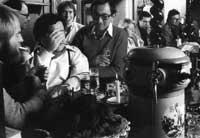GM cigars: safe tobacco
2002/04/07 Galarraga Aiestaran, Ana - Elhuyar Zientzia

According to the heads of the Health Administration, there is a direct relationship between smoking and some diseases (especially lung and heart diseases and cancers) and to demonstrate this, the clinical histories of 300 patients have been presented. In addition, they say that it is not a campaign against tobacco use, but that these large companies provide part of their benefits to cover the health damage they generate.
On the other hand, it is striking that the Spanish Government stands against a decision of the European Union shortly after the filing of the lawsuit. In fact, among measures to reduce tobacco use, the European Union proposes to grant smaller subsidies to tobacco producers. The government doesn't think it's a good idea, it must be borne in mind that 6,000 families of tobacco production live in Extremadura, very close to Andalusia.
In any case, the judicial struggle will be tough and warm, since the rivals are not of all kinds: Altadis (former tobacco), Philip Morris Spain, Tabacos Canary Island, British American Tobacco Spain, CITA and Jacos .T. International. However, if the sentence is favorable to the Public Health of Andalusia can cause a long string.
To address potential individual and government demands, or simply expand the market, Vector Tobacco, USA, has presented a transgenic tobacco without nicotine or inductive cancer.
Increased consumption of Liguht Tobacco

Cigarettes with low harmful substances and low amounts of nicotine, light tobacco already exist on the market. The growing number of medical tobacco tests has led to increased consumer concerns in recent years. However, many do not want to give up tobacco and for them they created the tobacco liguht.
Among those responsible for the bad reputation of tobacco are polycyclic aromatic hydrocarbons (HPA), catechols and nitrosamines, the three strong carcinogenic agents. The first two are produced as a consequence of the incomplete combustion of organic matter, so it is not enough to stop smoking to avoid them: although we are very hot in the stove, we have to choose again between pleasure and health! ). In addition, the HPA family is numerous and located in contaminated lands, vegetables, fruit and grilled food, among others. Nitrosamines are generated in the process of curing tobacco leaves.
In order to reduce these substances and nicotine, a physico-chemical treatment is applied to tobacco. In this way, producers believe that light tobacco harms less than normal, although like the rest is obliged to carry a notice from the health authority in the pack. Treatments are not entirely effective and harmful substances do not disappear completely. On the other hand, and as a result of treatments, tobacco loses in part its characteristic taste and smell.
Advantages of GM tobacco
However, according to Vector Tobacco, the catalytic process they have developed makes these carcinogens practically eradicated. However, the main novelty lies in the method used to eliminate nicotine.

Nicotine is an alkaloid inherent in tobacco. Like other alkaloids that have different plants, it has a pharmacological effect on humans and, incidentally, subjects the smoker to dependence on tobacco, as it generates dependence. The tobacco plant, for its part, is totally beneficial: it is born in the roots and accumulates in the leaves, where it protects the plant from insects.
In 1994, a biologist at North Carolina State University found the key for the tobacco plant to produce nicotine. He discovered the gene associated with nicotine production, but since it is essential for other plant functions, it was not possible to eradicate it. In early 1999, the company Vector Tobacco decided to participate in the research and, without damaging the sustainability of the plant or losing flavor, directed the research to the elimination of this gene.
Occasionally, research soon reaches its objectives: By mid-1999, the first non-nicotine transgenic tobacco was available in Vector Tobaco greenhouses. After many tests, the United States obtained the seed sowing permit and last year 1,200 Ha. production

Whether the U.S. Department of Health authorizes the production and sale of GM tobacco, consumers will have the last word. Despite the fact that in Europe consumers watch genetically modified foods with suspicion, in the US, from morning cereals to popcorn they eat at dusk in front of television, they are accustomed to eating such products. Therefore, it does not seem that this tobacco is transgenic.
Finally, a question: if that tobacco does not have nicotine, how will they get hooked on the smoker? The answer will come shortly from the US.
Published in 7K.

Gai honi buruzko eduki gehiago
Elhuyarrek garatutako teknologia




